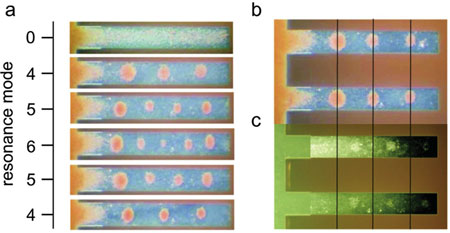| Posted: Jan 24, 2007 | |
Size-based sorting and manipulation of nanoparticles becomes possible |
|
| (Nanowerk Spotlight) The precise positioning of nanoparticles on surfaces is key to most nano- technology applications especially molecular electronics. However, for automated patterning of particles, existing methods are either slow (e.g., dip-pen lithography) or require prefabricated patterns (e.g., by electrostatic positioning or by successive self-assembly, transfer, and integration). Moreover, the sorting of differently sized particles, organelles, and cells in microfluidic networks is important for many biological and medical applications. Purely size-based sorting would offer the greatest control, but an automated method so far does not exist. Researchers in Switzerland now have discovered that acoustic streaming leads to sorting of particles dependent on their size. Nanoparticles aggregate at the antinodes and micrometer-sized particles aggregate on the nodes of oscillation patterns on micro- machined cantilevers. These surprising results open new possibilities for the sorting of nanoparticles. | |
| Current methods sort particles based on density and size (size selective precipitation, ratchets and the 'Brazil nut effect'), surface properties and size (high performance liquid chromatography), charge and size (gel electrophoresis), dielectric constant and size (dielectrophoresis), and acoustic impedance and size (ultrasonic separation). | |
| In 1787, the German physicist Ernst Chladni showed how sand particles could be made to self-organize into symmetrical patterns. Upon excitation of a metal plate with a violin bow, the sand on it would group along the nodal lines. The patterns, which vary with different modes of resonance, were named Chladni figures (or patterns). Chladni also reported how fine particles (fine shavings from the hairs of his violin bow) would move in the opposite direction, to the antinodes. The latter behavior was found by Faraday to be due to induced air currents, now known as 'acoustic streaming'. | |
| "While these classical, macroscopic Chladni pattern have been known for over 200 years, microscopic Chladni patterns have not been discovered so far" Dr. Ernst Meyer tells Nanowerk. "We were able, for the first time, to show the existence of microscale Chladni patterns. This opens entirely new possibilities to sort particles based on size." | |
 |
|
| (a) Time evolution of microbead patterns on one cantilever (length 560 m) upon sequential excitation of different resonance modes (no excitation, 4th, 5th, 6th, 5th, and 4th mode). The total time lapse was 2 min. (b) Patterns formed on two adjacent cantilevers by excitation of the 4th mode. Microbeads (4 µm) group on the antinodes, whereas nanobeads (0.5 µm) group on the nodes (c). Vertical lines mark the positions of the antinodes. (Reprinted with permission from the American Physical Society) | |
| Meyer, a professor of physics at the University of Basel/Switzerland, and his colleague Dr. Christoph Gerber, Director for Scientific Communication of the National Center of Competence for Nanoscale Science (NCCR) at the University of Basel, together with colleagues from the IBM research lab in Rüschlikon/Switzerland and Purdue University in the U.S. have shown that nanoscale oscillations of cantilever beams in liquid drive particles initially resting on the surface either to the nodes or to the antinodes, depending on their size. Similar to Faraday’s findings, the size dependency results from boundary streaming. However, the size dependency is found to be inverted at small scales. | |
| The researchers published their findings, titled "Chladni Figures Revisited Based on Nanomechanics" in the January 12, 2007 edition of Physical Review Letters. | |
| "We found microbeads to collect on the antinodes, whereas nanobeads moved towards the nodes of vibration" says Gerber. "This demonstrates the inverse size-dependent directionality as compared with Chladni’s observations owing to induced streaming of the liquid." | |
| The researchers point out that the applied analytical model for boundary streaming predicts a critical, frequency-dependent bead diameter at which beads reverse direction, which was experimentally observed. | |
| The demonstration of Chladni figures in microfluidics opens the door to highly parallel, directed assembly and to size-based sorting or size-dependent manipulation of particles, organelles, or cells. For instance, biosensors could differentiate molecules based on size or same-size carbon nanotubes could be assembled for nanoelectronics applications. | |
| Gerber and Meyer suggest that in sorting applications, particles on the nodes and antinodes could be transported along orthogonal paths such as dielectrophoretic paths. Combined with time segregation, this allows for additional selection on chemical composition of the separated objects. The propagation times can be tuned by the choice of surface chemistry and appropriate buffering of the solution. Sorting of more than two different sizes is possible by using harp-shaped cantilever arrays and sweeping through the consecutive resonance frequencies. | |
| In patterning applications, the use of membrane structures instead of cantilevers will offer a larger variety of patterns. Grouped particles can be fixed using laser curing, photopolymerization or selective electroless deposition on metal or polymer. After fixation, the liquid is removed and the patterns are transferred from the membrane to a chip surface by nanotransfer printing, leading to controlled, multistep assembly of biotechnological sensors or nanoelectronic circuits. | |
 By
Michael
Berger
– Michael is author of three books by the Royal Society of Chemistry:
Nano-Society: Pushing the Boundaries of Technology,
Nanotechnology: The Future is Tiny, and
Nanoengineering: The Skills and Tools Making Technology Invisible
Copyright ©
Nanowerk LLC
By
Michael
Berger
– Michael is author of three books by the Royal Society of Chemistry:
Nano-Society: Pushing the Boundaries of Technology,
Nanotechnology: The Future is Tiny, and
Nanoengineering: The Skills and Tools Making Technology Invisible
Copyright ©
Nanowerk LLC
|
Become a Spotlight guest author! Join our large and growing group of guest contributors. Have you just published a scientific paper or have other exciting developments to share with the nanotechnology community? Here is how to publish on nanowerk.com.
